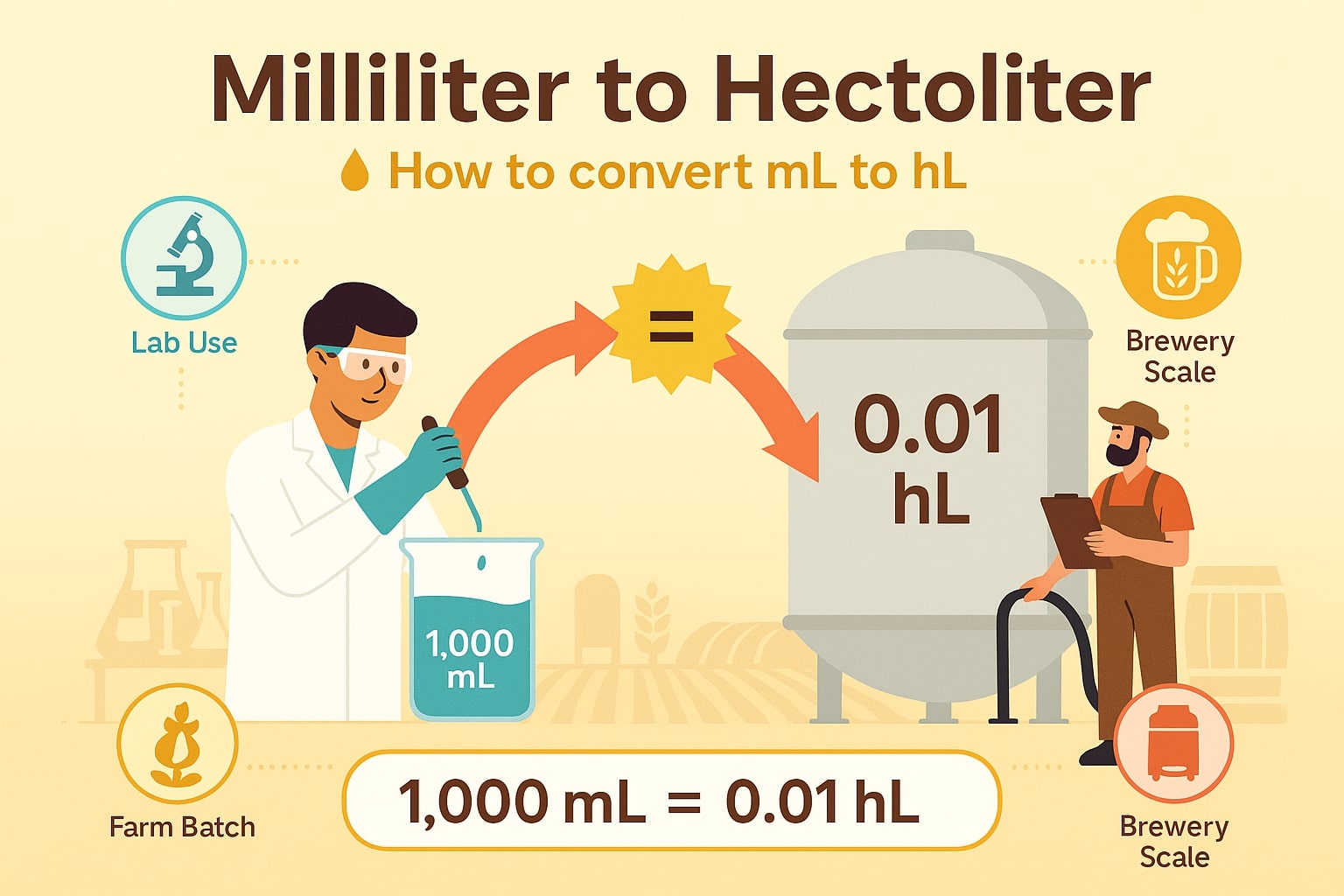milliliter to Hectoliter – How to convert mL to hL
Need to convert milliliter to hectoliter? This conversion is essential in agriculture, food processing, and beverage production where precise scaling of small liquid quantities to commercial volumes is necessary. Whether you're working in a laboratory, on a farm, or in a brewery, converting mL to hL ensures your calculations remain accurate from the smallest test sample to large batch outputs.
Want fast, reliable conversions? Use our Volume Converter. For a complete set of measurement utilities, visit the Conversion Tool hub.

Milliliter: The Small-Scale Standard
The milliliter (mL) is a widely used metric unit for measuring small amounts of liquid volume. It equals:
-
0.001 liters
-
1 cubic centimeter (cm³)
Milliliters are commonly used in:
-
Lab work (chemical reactions, sampling)
-
Pharmaceuticals and dosing
-
Food and drink portioning
-
Household and culinary applications
Milliliters offer high precision but become impractical when handling or reporting large-scale volumes — that’s where hectoliters come in.
Hectoliter: Volume for Production and Trade
The hectoliter (hL) is a metric unit equal to 100 liters or 100,000 milliliters. It is frequently used in:
-
Brewing and wine production
-
Agricultural reporting (grain, dairy, water usage)
-
Fluid logistics and trade documentation
-
Milk tank or silo capacities
1 hL = 100 L = 100,000 mL
Using hectoliters simplifies the handling and communication of large liquid volumes. For example, European breweries and winemakers report production in hL because it's concise and scalable.
How to Convert Milliliter to Hectoliter
To convert from milliliters to hectoliters, use the following formula: hL = mL ÷ 100,000 or hL = mL × 0.00001
Example: If you have 450,000 milliliters of olive oil: hL = 450,000 ÷ 100,000 = 4.5 hL
This is especially useful when a company scales a successful lab recipe or test batch to full production.
For mid-sized conversions like milliliter to liter, try our Milliliter to Liter tool (if applicable in your tool set).
Did you know?
-
In 2022, Italy produced over 40 million hectoliters of wine. That’s the equivalent of 4 billion liters or 4 trillion milliliters—making Italy one of the largest wine producers in the world.
-
A typical cow produces 25–30 liters of milk per day. Over a month, this equals roughly 9 hectoliters. That measurement helps dairy farms monitor production at the herd level.
-
In modern breweries, 1 hL of beer weighs about 105–110 kg due to its density and dissolved ingredients. This weight is factored into transportation and fermentation design.
-
The EU Common Agricultural Policy (CAP) requires farmers to report irrigation water usage in hectoliters, which helps track resource consumption and environmental impact.
-
Some portable sprayers used in orchards and vineyards dispense water or fertilizer in fixed volumes of 0.25–1 hL per spray cycle, allowing precise nutrient delivery.
Real-World Application: Scaling From Lab to Production
In food technology and R&D labs, recipes and fluid formulas are often developed using milliliters. A successful yogurt culture might be tested using 300 mL of base milk mixture. Once perfected, the formula must be scaled up to produce thousands of liters for commercial release.
To do this, producers convert their ingredients and additives from milliliters to hectoliters. For example, if a batch requires 300 mL of flavor per liter, the scaled formula for a 50 hL batch would need 15,000 mL (or 15 L) of flavoring—keeping proportions accurate across the entire production.
This process is repeated in winemaking, sauce bottling, juice processing, and even dairy pasteurization, where conversion between small-scale and bulk volumes ensures consistency and quality.
.jpg)
Conclusion
Whether you're formulating lab samples, managing dairy output, or scaling beverage recipes, converting milliliter to hectoliter is a vital skill for professionals in food science, agriculture, and liquid logistics.
Use our Volume Converter for fast, error-free conversion between mL, hL, and other units. Need broader tools? Browse our Conversion Tool library for everything from flow rates to area and energy calculators.
Working in systems where water or fluid management matters? Our Water Consumption Calculator or Flow Rate Calculator can help you apply these measurements directly to practical scenarios.
From milliliters in a lab to hectoliters in a warehouse—Jetcalculator equips you with precision every step of the way.

